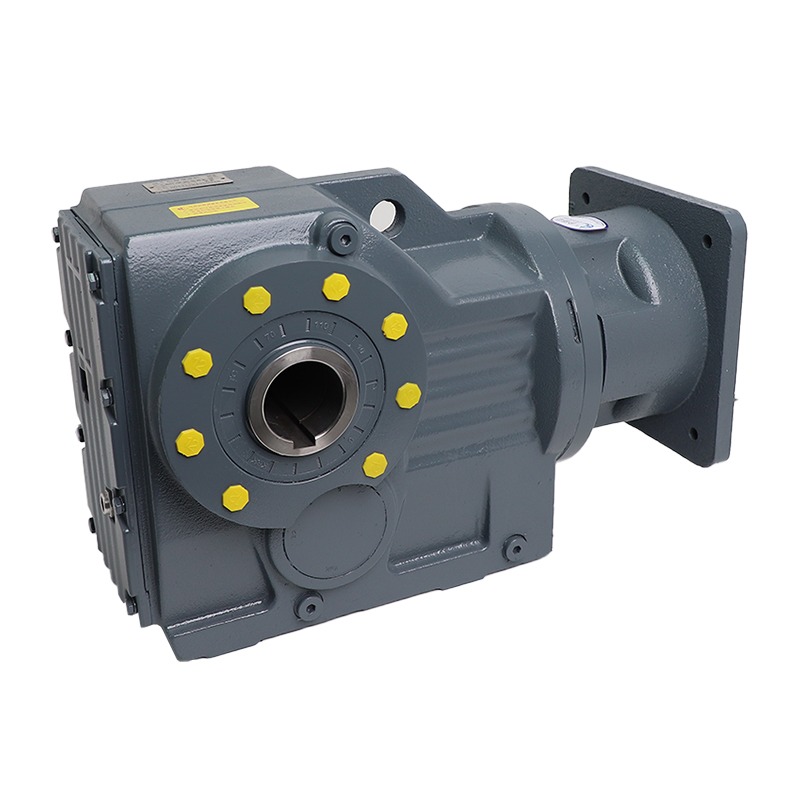 2025.08.04
2025.08.04
 Industry News
Industry News
In the dynamic landscape of modern industrial automation, the efficiency and stability of mechanical transmission systems are paramount, acting as the linchpin of production line performance. At the heart of this lies the right-angle output reducer, a crucial transmission component whose distinctive design enables it to excel in applications where space is at a premium or where a change in transmission direction is required. This type of reducer does more than simply decrease the input shaft’s rotational speed; it critically facilitates a 90-degree power turn, channeling the high-speed rotational energy from a servo motor to the actuating mechanism with remarkable efficiency and stability. The internal configuration, which includes a sophisticated arrangement of helical and bevel gears, guarantees smooth meshing and exceptional load-bearing capacity. This meticulous design significantly minimizes energy loss and operational noise. Consequently, for equipment with stringent demands on both space utilization and transmission efficiency, this reducer stands as an ideal solution, ensuring not only precise control but also a robust and powerful output.
Industrial machinery frequently operates under the dual pressures of heavy loads and the need for high precision. Hardened tooth surface helical bevel gear reducers are engineered specifically to meet these formidable challenges. The gear surfaces undergo a specialized hardening treatment, which dramatically enhances their surface hardness and wear resistance. This process not only extends the service life of the reducer but also guarantees its reliability and stability during prolonged, high-load operations. Moreover, the helical gear design, in contrast to straight-cut gears, offers a greater degree of overlap. This ensures that the gears distribute force more evenly during meshing, which in turn significantly reduces impact and vibration, thereby achieving a higher level of transmission accuracy. This characteristic is indispensable for automated equipment like robots and CNC machine tools, where precise control over position and speed is essential. When combined with their formidable high-torque output capability, these reducers can effortlessly manage the startup, acceleration, and braking of heavy-duty machinery, ensuring the entire system operates with impeccable smoothness and control.

The design and integration of complex automated production lines often face the constraint of limited installation space. The hollow shaft configuration of these reducers offers a significant advantage, providing immense convenience and flexibility for installation. Unlike traditional solid-shaft reducers, the hollow shaft design allows the reducer to be directly mounted onto the driven shaft using a connection flange or key, thereby eliminating the need for intermediate components like couplings. This not only simplifies the mechanical structure but also shortens the transmission chain. This design reduces installation space, lowers the overall weight of the equipment, and enhances transmission rigidity, minimizing the accumulation of errors. Furthermore, the horizontal hollow shaft design permits the reducer to be installed flexibly in horizontal, vertical, or any required orientation, easily accommodating complex equipment layouts and spatial limitations. Whether driving rollers directly, or connecting to conveyor belts and agitators, the hollow shaft reducer provides a wide range of installation options to meet the unique demands of various operating conditions.
High-precision reducers are an indispensable part of modern industrial automation. Their fundamental role is to transform the high-speed, low-torque characteristics of a servo motor into a low-speed, high-torque output, all while ensuring the transmission process remains smooth and precise. This transformative capability makes the reducer a vital “bridge” connecting the power source to the actuating mechanism. In the field of robotics, reducers are widely used in joints to achieve precise movements and powerful gripping forces. In the machine tool industry, they are integral to spindle and feed systems, ensuring both machining accuracy and efficiency. Within logistics automation, these reducers drive various conveyor belts and sorting equipment, enabling the rapid and accurate handling of materials. Additionally, in industries such as packaging, printing, and textiles, reducers play a crucial role by providing precise motion control that guarantees the stable operation of production lines and the quality of the final product. Essentially, the reducer is the bedrock upon which the high efficiency, high precision, and high reliability of industrial automation are built.
Selecting the appropriate reducer for your equipment is a technical decision that demands a comprehensive evaluation. Firstly, torque is the primary consideration. It is essential to determine the reducer’s rated torque based on the equipment’s actual load, startup torque, and working torque, while also allowing for an adequate safety margin. Secondly, the choice of transmission ratio is critical, as it dictates the extent to which the reducer can decrease the motor’s speed to match the required operating speed of the actuating mechanism. Furthermore, the precision requirements cannot be overlooked. For equipment demanding high-precision positioning, a reducer with minimal backlash and low transmission error should be chosen. Other important factors to consider include the installation method (e.g., horizontal, vertical, hollow shaft) and the specific working environment (temperature, humidity, dust levels, etc.). By thoroughly analyzing the equipment’s operational conditions and carefully evaluating the reducer’s performance parameters, you can make the most informed decision, ensuring your equipment’s stable and efficient operation for years to come.